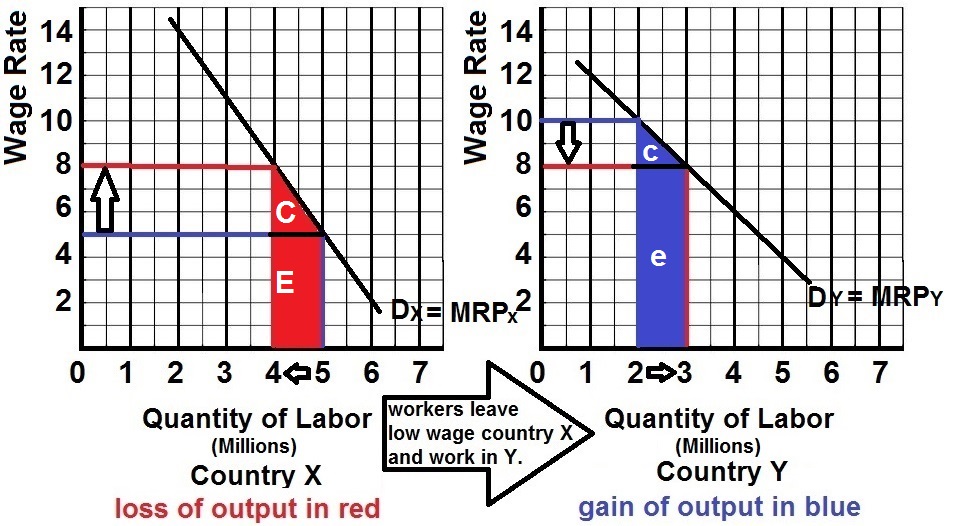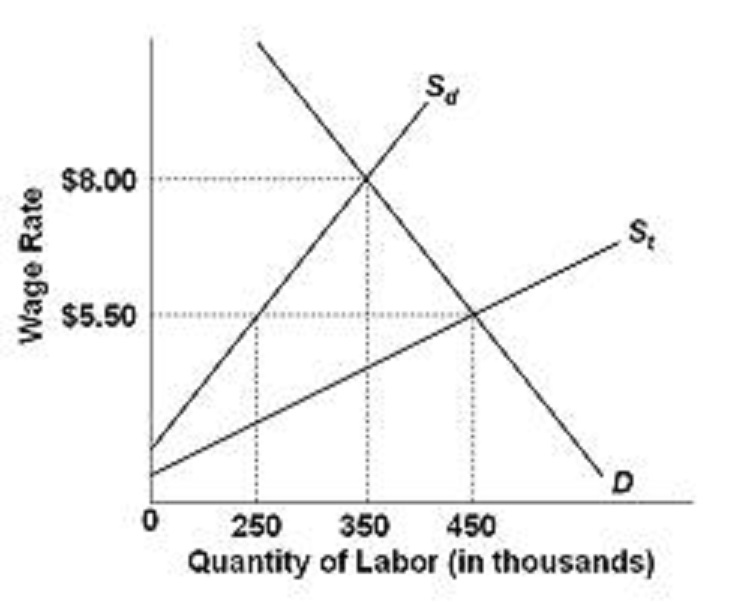|
A simple immigration
model showing the "Impact on Wage Rates, Efficiency, and
Output"
A model showing the
impact of illegal workers in a low wage labor
market
A Simple
Immigration Model Showing the "Impact on Wage Rates,
Efficiency, and Output"

Assumptions:
- Dx is the demand for labor in
country X; Dy is the demand for labor in country Y. The
demand for labor presumably is greater in the country Y
because it has more capital, more advanced technology,
and better infrastructure that enhance the productivity
of labor. Therefore wages are higher in country
Y
- before-migration the labor force
of country X is 5 million and the wage is $5
- before-migration the labor force
of country Y is 2 million and the wage is $10
- there is full employment in both
countries
- labor quality is the same in both
countries.
- migration (1) has no cost, (2)
occurs solely in response to wage differentials, and (3)
is unimpeded by law in both countries,
Conclusions:
- Workers will migrate from low wage
country X to high wage country Y until wage rates in the
two countries are equal at $8.
- At that level, 1 million workers
will have migrated from country X to Country Y.
- In country Y, the wage rate will
decrease from $10 to $8.
- In country Y the domestic output
(the sum of the marginal revenue products of the entire
workforce) will increase as shown by the blue area c + e.
- In country X, the wage rate will
rise from $5 to $8.
- In country X the domestic output
(the sum of the marginal revenue products of the entire
workforce) will decrease as shown by the red area C + E.
- Observe that the gain in domestic
output in country Y exceeds the loss of domestic output
country X. The migration from Y to X has increased the
world's output and income.
- Migration enables the world to
produce a larger output with its currently available
resources. So labor mobility joins international trade in
enhancing the world's standard of living.
A Model Showing
the Impact of Illegal Workers in a Low Wage Labor
Market

Assumptions:
- Employers in this market are
willing and able to ignore minimum wage laws
- Sd represents the supply of
domestically-born (and legal immigrant) workers
- St represents the total supply of
workers in this labor market (Sd plus illegal
immigrants
- The horizontal distances between
St and Sd at the various wage rates measure the number of
illegal immigrants offering their labor services at those
wage rates
- Unless otherwise stated, illegal
immigration is not effectively blocked by the
government.
Conclusions:
- With illegal workers present, as
implied by curve St, the equilibrium wage and level of
employment in this labor market are $5.50 and
450,000.
- At the low wage of $5.50:
- Only 250,000 domestic-born
workers are willing to work
- the other workers (200,000) are
illegal immigrants.
- Can we therefore conclude that
illegal workers have filled jobs that most U.S.-born
workers do not want?
- The answer is "yes," but only
with the proviso: "at wage rate $5.50"
- if the United States cut off
the full inflow of illegal workers to this market, the
relevant supply curve would be Sd and the wage rate
would rise to $8.00. Then 100,000 more domestic-born
workers would work and 200,000 illegal immigrants
would lose jobs.
- Can we therefore conclude that
illegal workers reduce the employment of Americans by an
amount equal to the employment of illegal workers?
No.
- Illegal immigration causes some
substitution of illegal workers for domestic workers,
but the amount of displacement is less than the total
employment of the illegal workers. Illegal
immigration, as with legal immigration, increases
total employment in the United States.
|